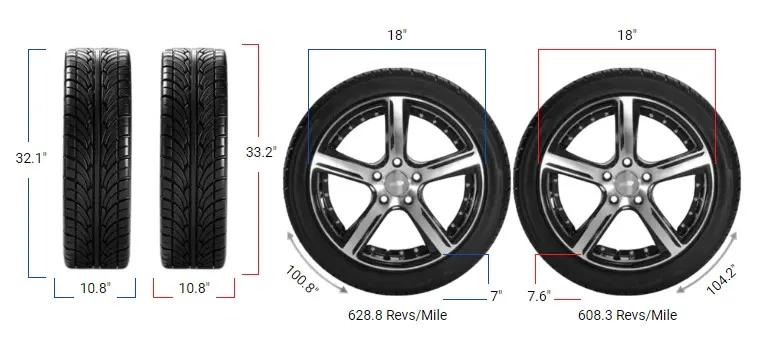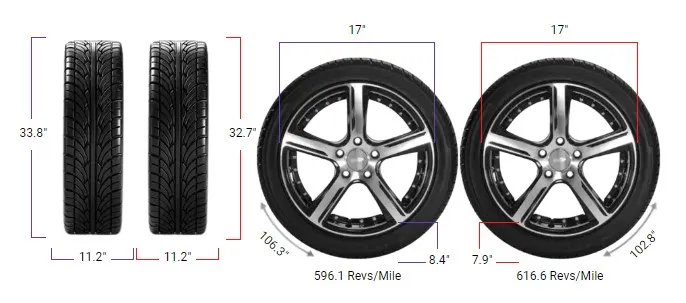Tire Size 215/85r16 vs 225/75r16

Switching tire sizes can feel like a small tweak, but it often brings significant changes in performance. If you’re considering moving from 215/85R16 to 225/75R16, here’s everything you need to know to make the right choice.
- The wider tire offers improved road traction and stability.
- The wider stance provides a more aggressive and rugged appearance.
- Ride comfort may be a bit firmer due to the shorter sidewall height.
- Reduced ground clearance may increase the risk of scraping on rough terrain.
- The smaller diameter might result in slightly better fuel efficiency on paved roads.

Fitment Guide
In this case, the diameter of the 225/75R16 tire is 3.6% smaller than the 215/85R16. This difference exceeds the recommended range, meaning switching to 225/75R16 could potentially lead to issues.
However, it might still be doable with some adjustments, but careful consideration is needed to avoid rubbing or clearance problems.
On-Road Impact
Switching to 225/75R16 will have noticeable effects on-road, especially in areas like ride comfort and speedometer accuracy. Since the 225/75R16 tires are shorter in diameter and wider, they will lower your vehicle’s stance slightly, which can change how the vehicle feels on the road.

- Ground Clearance: With the 225/75R16 being 1.1 inches shorter, your vehicle will sit a little lower. This can reduce ground clearance, which may affect driving over obstacles or uneven terrain.
- Ride Comfort: The shorter sidewall of the 225/75R16 (6.64 inches vs. 7.19 inches) means less cushioning between your vehicle and the road. This can lead to a stiffer ride but may also improve handling due to reduced sidewall flex.
- Speedometer Accuracy: Due to the smaller circumference, your speedometer will read slightly higher than your actual speed. For example, at 20 mph, you would be traveling at 19.27 mph with the 225/75R16 tires.
- Gas Mileage: The wider tires (8.86 inches vs. 8.46 inches) create more surface contact with the road, increasing rolling resistance. This could result in a slight decrease in fuel efficiency.
- Handling and Stability: The wider contact patch of the 225/75R16 offers better grip, improving stability, especially in corners. However, the shorter sidewall may lead to slightly reduced comfort over bumpy roads.
Off-Road Impact
For off-road enthusiasts, tire size can greatly influence performance. The switch to 225/75R16 will affect how your vehicle handles rough terrain, including rocks, mud, and dirt trails.

- Ground Clearance: The reduced ground clearance of 1.1 inches can become an issue when navigating rocky or uneven terrain. You may be more likely to hit obstacles that the taller 215/85R16 would clear.
- Durability & Wear: Off-road conditions can be harsh, and while the wider 225/75R16 provides more traction, it may also wear out faster due to increased surface area exposure, especially on rocky surfaces.
- Ride Comfort: A lower, stiffer tire can reduce comfort when driving over rugged terrain. The smaller sidewall of the 225/75R16 provides less cushion, meaning bumps and dips will be felt more sharply than with the taller 215/85R16.
- Aesthetics Look: If you’re after a more aggressive, rugged look, the 225/75R16 may appear less imposing due to the reduced height. The 215/85R16 gives a taller profile, which is often preferred for off-road appearances.
215/85r16 vs 225/75r16
| Feature | 215/85R16 | 225/75R16 | Difference |
|---|---|---|---|
| Diameter inches (mm) | 30.39 (771.9) | 29.29 (743.9) | -1.1 (-28) -3.6% |
| Width inches (mm) | 8.46 (215) | 8.86 (225) | +0.39 (+10) +4.7% |
| Circumference inches (mm) | 95.47 (2425) | 92.01 (2337.03) | -3.46 (-87.96) -3.6% |
| Sidewall Height inches (mm) | 7.19 (182.75) | 6.64 (168.75) | -0.55 (-14) -7.7% |
| Revolutions per mile (km) | 663.65 (412.37) | 688.63 (427.89) | 24.98 (15.52) 3.8% |
| Speedo Reading | 20 mph (32.19 km/h) | 19.27 mph (31.02 km/h) | -0.73 mph (-1.17 km/h) |
Difference Between 215/85r16 and 225/75r16
The main difference between 215/85R16 and 225/75R16 is the diameter. The 215/85R16 tire has a diameter of 30.39 inches, while the 225/75R16 is smaller at 29.29 inches, a difference of 1.1 inches.
Can I Use 225/75r16 Instead of 215/85r16?
You can use 225/75R16 instead of 215/85R16, but the diameter difference of 3.6% exceeds the recommended 3%. Some adjustments may be necessary to avoid issues like rubbing.
How Much Taller Is a 215/85r16 Tire Than a 225/75r16?
The 215/85R16 tire is 1.1 inches taller than the 225/75R16 tire. This height difference can affect ground clearance and may impact both on-road and off-road performance.
How Much Wider Is a 225/75r16 Tire Than a 215/85r16?
The 225/75R16 tire is 0.39 inches wider than the 215/85R16. This increased width improves road grip, but it may slightly reduce fuel efficiency due to higher rolling resistance.
Our Observation
Switching from 215/85R16 to 225/75R16 presents both benefits and drawbacks, depending on your driving conditions.
On the road, the 225/75R16 offers improved handling and a slightly stiffer ride, which can be advantageous in corners and at higher speeds.
However, the reduction in ground clearance and the less cushioned ride could be a downside for those driving over uneven or rough roads frequently.
Off-road, the smaller diameter of the 225/75R16 could result in clearance issues when navigating rocks or dips. Additionally, while the wider tire provides more grip, it may lead to faster wear and less overall ride comfort.
Ultimately, the decision comes down to personal preference and the type of driving you do most often.
For daily city driving, the 225/75R16 could be a solid choice, but for off-road enthusiasts, the 215/85R16 may be the better option for its taller profile and superior ground clearance.



